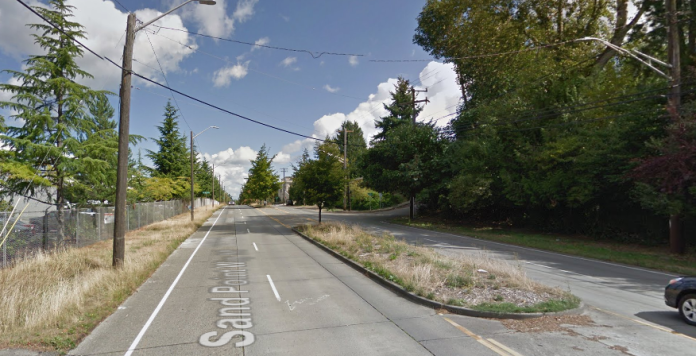Last night, the Seattle Department of Transportation (SDOT) hosted a meeting to describe potential safety improvements to Sand Point Way NE. The Urbanist has already covered some of the proposal, but here’s additional information from the meeting.
The SDOT meeting was well attended by over 40 people. This safety project began as a neighborhood grant to do a study, which the Northeast District Council and SDOT both approved. The woman who applied for the grant described walking along a part of Sand Point Way that lacks sidewalks and being terrified as a car veered towards her at over 40 mph. This made her both scared and angry enough to begin figuring out how to get sidewalks built.
While the grant she obtained can’t fund the safety improvements, the Move Seattle levy includes around $1.5 million in Vision Zero funding specifically earmarked for Sand Point Way. Unfortunately, the study identified a need for around $10 million in funds, so additional money will be needed to do many of the proposed changes.
The study looked at the existing conditions along Sand Point Way NE, and specifically traffic speeds, vehicle volumes, and roadway width. The posted speed limit along the corridor is 40 mph. They found that many drivers were obeying the speed limit, with 85th percentile speeds around 43 mph. However, they also noted many collisions, and also measured some drivers speeding at 65 mph! Numerous people were also driving off the road.
Traffic volumes were very similar along different stretches of the roadway, which made for an interesting graph. Parts of Sand Point Way with two and three lanes handled roughly the same amount of traffic as the parts with four and five lanes. This makes a strong case for being able to remove lanes without impacting traffic throughput or congestion. Of course, as we know from past road diets, in many cases turning four lanes into three can actually improve travel times thanks to the added center turn lane.
The roadway width and configuration was studied by a consultant (MIG|SvR), who identified a number of possible improvements. Much of what they proposed was focused on keeping costs low.
For example, rather than building brand new sidewalks, they proposed turning existing vehicle travel lanes and asphalt into sidewalks by adding some type of (still to be determined) protection. The lion’s share of improvements would be paint and installed protection, with a few of the intersections getting expensive traffic lights and other improvements.
In the end, the goal was to get Sand Point Way to work for pedestrians and drivers, with a lower design speed and sidewalks being created. The proposal also included pull-in stops for buses. For some reason, SDOT wasn’t interested in lowering the posted speed limit. They claimed that it would require a multi-year study (which didn’t make sense to me, given that we were just able to lower all arterial speed limits downtown to 25 mph without any studies). Portions of Sand Point Way south of NE 65th St were dropped from the project, due to being owned by Washington State Dept of Transportation; this seemed to upset a lot of people at the meeting. Neither of those points are reflected in the original proposal that was passed around.
Bikes were mentioned only in the beginning of the presentation, in the context of “we need to make it work for bikes on the Burke-Gilman” and mentioning that kids sometimes bike in the scary gravel shoulder. There didn’t appear to be much concern about creating a safe space for people who wanted to bike on Sand Point Way.
At the end of the meeting, SDOT asked for a quick show of hands to see who liked the proposed design changes, and who didn’t. Roughly three-quarters of the audience were in favor of the improvements. Those who were opposed seemed mostly concerned about congestion.
SDOT is not currently willing to put any information about this project on their website, but the project managers Shauna Walgren and Howard Wu can be reached at shauna.walgren@seattle.gov and howard.wu@seattle.gov. The project is still very early in the design phase, and we can assume that there will be information online and another open house once it is further along.

Andres Salomon (Guest Contributor)
Andres Salomon is a dad, safe streets advocate, and former mayoral candidate. He lives in Northeast Seattle.

